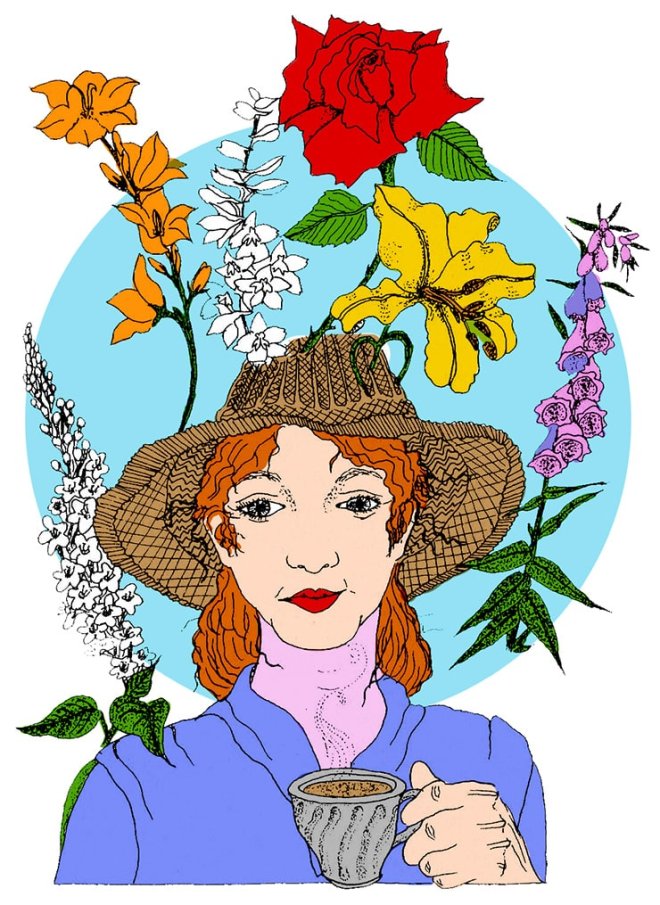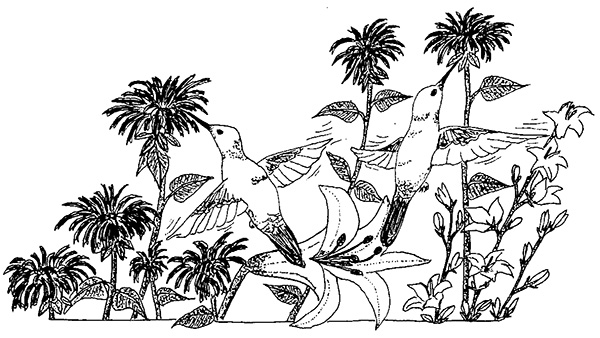Read by Matilda Longbottom
Being English and a gardener has certain drawbacks, especially if one is tall and thinnish-and wears a sun hat and skirt, rather than a baseball cap and shorts. People expect an expertise I cannot live up to. It is no good explaining that the sun on my neck bothers me, that I no longer have “Cuisses de Nymphe” (and if I cannot be pruned, I had better be covered), and that my British accent is more a matter of habit than horticultural intelligence. I am still expected to know all about perennials, to murmur about phystostegia, as I pull on my wash-leather gloves, to pour afternoon tea under the liquidambar, and to trudge pluckily out to the galanthus in the snow. People are always asking me the names of flowers or what they should plant in their borders.
The truth is that Vita Sackville-West, while contributing immeasurably to gardening and garden writing for all time, is a bit hard for ordinary English ladies to live up to, yet what American does not immediately think of Vita when he or she meets an English garden lady?

Any American gardener who goes to England will almost certainly visit Sissinghurst. The gardens there are very beautiful, and I have visited them myself. Most people who go there come back full of zeal to make a one-colour garden, usually a “white garden.” I was no exception: Cool underplantings of artemesias, santolinas and achilleas, white delphinium, white foxgloves, tree peonies, white campanulas, and what Vita calls “Dozens of white Regale lily (grown from seed),” filled my thoughts. I had visions of such a garden by moonlight, with great hawk moths hovering over the moonflowers, with subdued lights slanting across the darkening lawn, with muted but brilliant conversation wafting through the heavy scent of the tuberroses, the Matthiola, the Nicotiana, and the Zaluzianskya. All this would be preceded by a dinner of chicken breasts, poached in white wine, blanched endive, and meringues. My dress for the occasion would be . . .
It is always good to remember that Vita Sackville-W est, though a relentless gardener, had several people about the place to help implement her visions. It is so with most of the great gardens of the world. So, for us, inspiration must be tempered with reality, and sometimes that has a way of changing things more than we expected.
I did not think, when it actually came to planting, that I would have a wholly white garden. This was partly because, before I had started on the venture, I had been seduced by a mail-order company into buying three incredible roses for the price of one, an absolutely (as they informed me, and I agreed) “irresistible” offer. The roses were white, pink, and something called “French Lace,” evoking images of a dreamy night in Paris. All white, I then decided, would be stark, but I would aim for pastels, pale pinks and blues, blushes and sunsets. My American mother-in-law, to whom I confided my plan, said she always liked “a show” herself, but, not surprisingly, that did not discourage me in the least.
Gardening, for some reason, has always been slightly intertwined with morality, at least in the Western world. Adam, we are told, named everything in his garden, but then got in trouble when his wife wanted a more encyclopedic knowledge, and ever since then, gardens, in Western thought, were judged as expositions of right thinking. (The Eastern gardens, in contrast, had nothing of this. They were shamelessly built as centres of love and pleasure.) In the West, the tradition of not only not particularly liking a certain kind of garden, but of actually thinking of it as wrong, is still with us. Francis Bacon scathingly dismissed a type of gardening he disliked (topiary) as “for children.” In the time of Rousseau, the trend to “natural” gardens reflected the politics of the time. Olmstead’s American parks were a manifestation of democratic thought. Even nowadays, if we do not like a gardening style, we are apt to condemn the very soul of its creator.
English gardens, as with English manners, are supposed to be impeccably tasteful. The current epitome of such taste is the one-colour garden. Yet, as you will have guessed, I no longer have a bed of muted pastels, reminiscent of French lingerie, and the reasons are many. The first is the Oriental poppies. I obtained from the WhiteFlower Farm nursery, two poppies called “Marshall von der Goltz” and “Show Girl.” The first was white, the second, “a bewitching pink.” The combination, had it worked, would certainly have been reminiscent of Paris, and those delicious war stories of heart-rending ties between Teutonic generals and French showgirls. But poppies, like people, have a way of reverting to type, and the glorious scarlet bastards that soon populated my pastels were no exception. As everyone knows, you cannot move poppies. So there we were.
Of course, by mid-June we could have been pastel again, if it hadn’t been for the hummingbirds. Someone gave me some lovely red Monarda, which I planted in a bed a little further away from the house. The hummingbirds worked it ceaselessly, but I wanted to have them nearer the porch. I thought of luring them with red sugar-water, in a little kit the catalogues informed me would keep them by me always. I even bought the little kit, but then forgot to fill it with the red sugar, and, meanwhile, the Monarda had not forgotten to bloom and the hummingbirds were always out of sight. I tried some white Monarda called “Snow Queen,” which was about as attractive to hummingbirds as one could expect a plant of that name to be. Then, one day, I simply took a shovelful of the lovely red Monarda, plunked it right in the middle of the pastels, and settled down to watch the magical little birds fight over it.
After that, vulgarity took over, for hummingbirds, like my mother-in-law, love showy flowers. They work magenta foxgloves with enthusiasm. They love cardinal flowers. They love trumpet vine. Bright red climbing beans look well, I discovered, next to pale mauve clematis, as long as there are hummingbirds zooming in on the resulting combination. The final capitulation was salvia, fiery red salvia, the kind you see in parks and banks, and never in pastel English gardens. And just to show that democracy has won the day, I have planted bronze-leaved dahlias with pink, yes pink, chrysanthemums next to them. I am finally freed from Sissinghurst, and I finally feel a little bit American.

Tea time now includes hummingbirds. I confess I have not yet taken to American iced tea and want my hot cuppa with milk and biscuits (cookies), but I feel my garden, in its glorious and brass vulgarity, is making a statement. It is affirming that I am part of a nation that does not believe in “all white” anything, even a garden. I have managed, like everyone else, to make my garden a manifestation of my morality: a mix of old and new, anything that will best flourish there and with nothing excluded because it is the wrong colour. I am as complacent as I used to be when I had “good taste,” because morality is still on my side, as it always is when people take up a new gardening idea. For gardening is the re-creation of our own little worlds, where we have our own rules, and dissenters are derided.
When I walk in the garden, in the cool of the evening, I do not see great hawk moths, smell the heavy nicotiana, or, I am afraid, hear voices other than my mother-in-law’s television news through the window. I will not have dined on breast of chicken and white wine. “French Lace” was eaten by Japanese beetles and Paris … well, Paris is far away. But hummingbirds hover fearlessly right next to my chair and, every year, they come from more miles away than my imagination can take me, to the glories of my salvia, my trumpet vine, and my bee balm. ❖


 Previous
Previous


